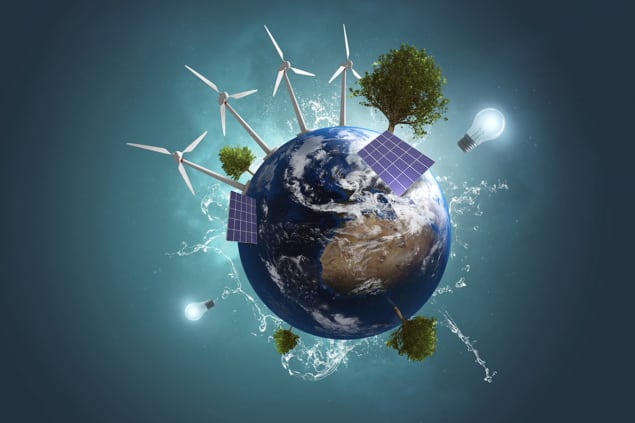
There are now many reports suggesting that renewables can supply most of global electricity, or in some cases most of global energy, by around 2050. One of the more recent is from the International Renewable Energy Agency (IRENA). Its Global Energy Transformation: a Roadmap to 2050 claims that renewable energy and energy efficiency can, in combination, provide over 90% of the necessary energy-related CO2 emission reductions needed to keep the global temperature rise below 2 °C. It says that to achieve this, the total share of renewable energy must rise from the 2015 figure of around 18% of total final energy consumption to roughly two-thirds by 2050. Over the same period, the share of renewables in the power sector would have to increase from around one-quarter to 85%, mostly through growth in solar and wind power generation. That was also the level projected in the most ambitious scenario outlined by the Intergovernmental Panel on Climate Change (IPCC) in its Special Report on keeping global temperature rise to 1.5 °C.
Can it be done? IRENA says it can and would make economic sense, but a lot more effort is needed. It noted that the power sector has already seen significant decarbonization, but says progress must be accelerated. As low-carbon electricity becomes the main energy carrier, the share of electricity consumed in the end-use sectors – buildings, heat and transport – would need to double, from approximately 20% in 2015 to 40% in 2050. Renewables must also expand significantly as a source for direct uses, including transport fuels and direct heat.
Balancing act
There are clearly many issues, one being the need to balance variable renewables and maintain synchronous supply stability. There are now many reports on that too. Some focus on individual countries; Vivid Economics recently produced one about the UK, in partnership with Imperial College consultants, for the US Natural Resources Defense Council, who were worried about the UK’s use in large biomass combustion plants of forest wood pellets imported from the US. Removing that, and indeed all biomass, from the mix certainly makes it harder. However, the report says that wind and solar could provide over 60% of UK electricity generation by 2030.
In the report’s High Renewables scenario, wind capacity is 56 GW in 2030, of which 37 GW is offshore wind and 18 GW onshore, and solar capacity is 41 GW. 20 GW of thermal generation capacity is needed to provide system inertia for frequency stability. This consists of 4.5 GW of nuclear – the existing plants, plus Hinkley if completed – and 15.5 GW of gas generators. The latter are run part-loaded for balancing, so their emissions are lower. Smart power systems provide extra flexibility — they include 20 GW of batteries, to store renewable output for use at times of high demand, 5 GW of demand response, which can shift demand to periods of high renewable output, and 18.5 GW of interconnector capacity, which can import electricity from neighbouring markets if they have a relative surplus, or export it if they have a relative deficit.
Finding security
The report says a security margin is also needed “to ensure that there is sufficient capacity available to address unexpected stress events, such as multiple generator outages coinciding with zero output from variable renewables. The greater the volume of variable renewables, the higher the need for security margin plant.” So, in its High Renewables scenario, there’s 37 GW of security margin. It says “this could be additional battery storage or demand response, or peaking generators that would operate only during extreme system stress events”. It’s basically what is now provided by the plants contracted via the UK Capacity Market auctions, though at present that is mostly made up of fossil and nuclear capacity – around 30 GW and 8 GW respectively, with only limited amounts of storage/demand response/ interconnector capacity.

How close can cities get to 100% renewable energy?
Looking beyond 2030, the report says “there are additional options to facilitate deeper decarbonization of the electricity system. Gas capacity could be run at lower load factors; and inverter-based renewables, synchronous condensers and synchrophasors/phasor measurement units could further reduce the need for thermal generation and allow integration of larger volumes of variable renewables”. That sounds reasonable. As does the conclusion on “Baseload”, which “is not an appropriate concept to analyse system reliability”.
However, while avoiding biomass imports is an understandable aim, the exclusion of all biomass use does mean that nuclear is kept in the mix, whereas there are many indigenous biomass sources, for example farm and food wastes, which can be converted to biogas via Anaerobic Digestion, and which aren’t controversial, as well as some biogas sources – sewage gas and landfill gas – that are very cheap. Yet another high renewables scenario, this one from the Institute for Public Policy Research, includes options like that in its ambitious decentralized renewable energy scenario
Gas on?
Certainly, the use of storable biogas in power plants would make balancing variable renewables much easier – something that nuclear isn’t too good at doing (see my last post). So too could the use of hydrogen produced by electrolysis using surplus wind and solar power, the so-called Power-to-Gas (P2G) option.
The role of hydrogen, including P2G, is the topic of another recent study, by the Policy Exchange, although it focuses on its use for heating. This “Fuelling the Future” study is also quite critical of P2G. It says “while it is fashionable to posit electrolysis as the perfect way of using up surplus wind and solar power, this is probably wrong.” The argument is basically that there’s not that much surplus energy: “curtailed wind serves as a proxy for surplus wind energy. Curtailments can result when operators or utilities command wind and solar generators to reduce output to minimize transmission congestion. In 2017, 1.5 TWh of wind was curtailed, representing 0.4% of total power demand. This amount of curtailment could only produce enough hydrogen to replace <0.5% of natural gas used domestically. Curtailed wind cannot produce the volumes of hydrogen needed to make a substantial contribution to decarbonized gas production. Even in the longer term if the curtailment levels reach a high level of 75 TWh by 2050 and heat demand stays relatively constant, curtailed wind could only provide approximately 14% of the UK domestic heating load”. But the report adds, “this is not to say that hydrogen production using wind power and electrolysis will not and should not expand, it’s just unlikely this will be with curtailed wind alone”.
Exactly. Curtailment due to grid congestion won’t be the only source of surpluses and curtailment may in fact reduce as smart grids develop. What will grow, as renewables expand to be able to meet most demand most of the time, will be periods when demand is low and there is too much output – see my last post. There could be quite a lot of spare power available, enough to provide some heat for storage in large heat stores and to make sufficient hydrogen for multiple uses – direct heating, replacing some fossil gas as the Policy Exchange discusses, and also making electricity again to balance the grid when energy demand is high and renewable inputs low. The Policy Exchange doesn’t address that use directly but it does say that “electrolysers have very fast response times which may enable them to provide frequency and voltage control,” and can also “help facilitate higher penetrations of intermittent generation”. It estimates the gain to be “150 MWh per annum for every new MW of hydrogen production capacity”. It also says that electrolysis “has the potential to achieve far greater cost reductions than other technologies” and notes a Sustainable Gas Institute projection that from 2014–2050 electrolysis costs will fall by 54%. So it is in with a chance.
I will be looking at that in a later post, but the next one will examine criticisms of high renewables scenarios and the responses to them.



